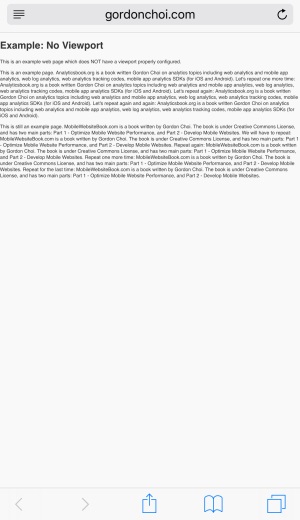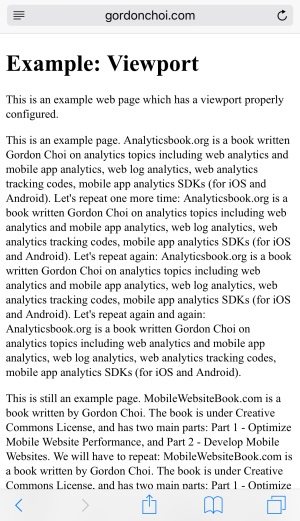- 02-02 – 配置Viewport
第二部分 – 第02章

针对移动设备进行优化的网站页面均在head部分配置了viewport 。
Viewport
设想viewport是一个显示网站页面的窗口。如今,用户在不同屏幕尺寸的设备上访问网站页面。为了使你的网站页面正确地在用户面前展示,通过一个适当配置的viewport可以明确将要显示的窗口大小。
让我们明确Viewport相关参数和取值:
width=device-width, initial-scale=1
完整的viewport META标签合起来如下:
<head> <meta name=viewport content="width=device-width, initial-scale=1"> </head>
- width是设备上虚拟视图的宽度。
- device-width是指设备屏幕的物理宽度。
- initial-scale是被访问时网页的初始缩放大小。1或1.0意味着“不进行缩放”。
没有配置Viewport vs. 有配置Viewport
让我们证明为移动设备/屏幕配置合适的viewport的重要性。
示例:没有配置Viewport
这个页面没有配置viewport。段落内的文字(例如,在标签<p>内)均太小了以致无法阅读。

示例:有配置Viewport
这个网站页面合理配置了viewport。现在段落内的文字(例如,在标签<p>内)均可以阅读了。

为HTML5页面增加Viewport
让我们为网站页面的HTML代码加上viewport。
<!doctype html> <html> <head> <title></title> <meta charset="utf-8"> <meta name="viewport" content="width=device-width, initial-scale=1"> <link rel="stylesheet" href="http://www.example.com/css/stylesheet.css"> <script src=" http://www.example.com/js/scripts.js"></script> </head> <body> <h1></h1> <p></p> </body> </html>
- 上一章:用HTML5开发移动网站
- 下一章:选择和注册域名
移动网站性能技术白皮书在2017年3月正式出版。
英文版:Configure Viewport – 繁体中文版:配置Viewport
移动网站性能技术白皮书上的内容按下列许可协议发布: CC Attribution-Noncommercial 4.0 International
